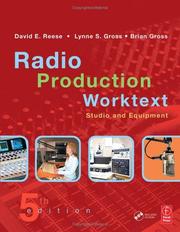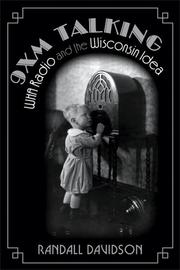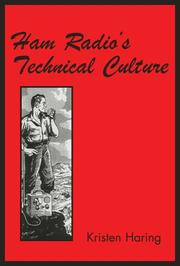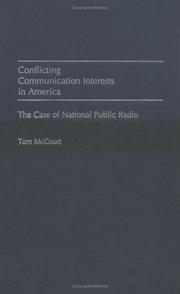| Listing 1 - 10 of 20 | << page >> |
Sort by
|
Book
ISBN: 1612497705 Year: 2022 Publisher: United States of America : Purdue University Press,
Abstract | Keywords | Export | Availability | Bookmark
 Loading...
Loading...Choose an application
- Reference Manager
- EndNote
- RefWorks (Direct export to RefWorks)
"Indiana's first radio station founded at Purdue University in West Lafayette, Indiana, on April 4, 1922. Richly illustrated with more than 150 photos, the book chronicles the station's evolution over the years, while highlighting the staff, students, and volunteers significant to WBAA's success. WBAA began as a lab experiment conducted by Purdue electrical engineering students in 1910. Later, the station became a vital method for Purdue's Cooperative Extension Service to broadcast the knowledge of the university, particularly agricultural news, to the people of the state. From the 1960s to1980s, WBAA aired Purdue basketball and football games, with station manager John DeCamp as the "Voice of the Boilermakers." In 1971, WBAA became a member station of National Public Radio (NPR), offering popular programming such as All Things Considered and Morning Edition. Listeners tuned into WBAA to hear classical, jazz, and international music, along with in-depth news reporting. Mayors and Purdue presidents aired weekly programs. WBAA gave a voice to arts and community organizations. Read about the invention of the first all-electronic television by pioneering Purdue scientist Roscoe George; WBAA's long-running School of the Air educational program deemed the "invisible textbook"; and the Midwest Program on Airborne Television Instruction (MPATI), an airplane that transmitted videos to schools while flying over six Midwestern states in the 1960s. Famous WBAA alumni include NBC sportscaster Chris Schenkel, comedian Durward Kirby, Today Show newscaster Lew Wood, Indiana State Representative Sheila Klinker, actress Karen Black, and actor George Peppard, among others. From the vacuum tube era to the digital age, this thoroughly researched book brings to light the intriguing backstories of the esteemed one hundred-year history of WBAA"--

ISBN: 0240806905 Year: 2006 Publisher: Oxford Focal Press
Abstract | Keywords | Export | Availability | Bookmark
 Loading...
Loading...Choose an application
- Reference Manager
- EndNote
- RefWorks (Direct export to RefWorks)
Radio stations --- Radio --- Sound --- Equipment and supplies --- Production and direction --- Recording and reproducing
Book
ISBN: 9783506760456 3506760459 9783657760459 3657760458 Year: 2021 Publisher: Paderborn Brill | Schöningh
Abstract | Keywords | Export | Availability | Bookmark
 Loading...
Loading...Choose an application
- Reference Manager
- EndNote
- RefWorks (Direct export to RefWorks)
Der Glaube an die Segnungen, aber auch die Zwangsläufigkeit des technischen Fortschritts entwickelte sich in der Phase des Hochimperialismus zu einer wirkmächtigen Ideologie, von der auch deutsche Ingenieure profitierten.Das Buch legt den Schwerpunkt der Analyse auf die ehemaligen Kolonien Deutsch Ost- und Deutsch-Südwestafrika. Der Fokus liegt dabei auf der Gruppe der technischen Experten, die mit dem Bau von Eisenbahnen, Straßen und Häfen einen entscheidenden Anteil an der Machtsicherung, Erschließung und Ausbeutung der Kolonien hatten. Neben der Exotik, monetären Anreizen sowie dem Prestige, das eine Tätigkeit in Afrika versprach, zog es Ingenieure vor allem aufgrund einer speziellen "Ideologie der Erschließung" in die sogenannten Schutzgebiete. Die spezielle Gruppenidentität als Kolonialingenieure, die sich in der Folge herausbildete, lässt sich in Artikeln und Vorträgen bis in die 1940er Jahre nachweisen und wirkte sich selbst noch auf die Ansätze der frühen Entwicklungshilfe aus.
Amateur radio stations --- Radio operators --- Radio --- Wireless operators --- Ham radio --- Radio stations --- Operators --- Amateur radio stations. --- Radio operators. --- Ingenieur --- Kolonialismus --- Imperialismus --- Infrastruktur --- Afrika --- Eisenbahn --- engineer --- colonialism --- infrastructure --- Africa --- railway --- History --- Germany --- Afrique --- Sub-Saharan Africa --- Colonization --- Technological innovations. --- Technological innovations --- Colonial influence. --- Colonies --- Innovations --- Influence coloniale.
Book
ISBN: 9780226194370 022619437X 9780226896168 9780226896182 0226896161 0226896188 Year: 2014 Publisher: Chicago : University of Chicago Press,
Abstract | Keywords | Export | Availability | Bookmark
 Loading...
Loading...Choose an application
- Reference Manager
- EndNote
- RefWorks (Direct export to RefWorks)
If you drive into any American city with the car stereo blasting, you'll undoubtedly find radio stations representing R&B/hip-hop, country, Top 40, adult contemporary, rock, and Latin, each playing hit after hit within that musical format. American music has created an array of rival mainstreams, complete with charts in multiple categories. Love it or hate it, the world that radio made has steered popular music and provided the soundtrack of American life for more than half a century. In Top 40 Democracy, Eric Weisbard studies the evolution of this multicentered pop landscape, along the way telling the stories of the Isley Brothers, Dolly Parton, A&M Records, and Elton John, among others. He sheds new light on the upheavals in the music industry over the past fifteen years and their implications for the audiences the industry has shaped. Weisbard focuses in particular on formats-constructed mainstreams designed to appeal to distinct populations-showing how taste became intertwined with class, race, gender, and region. While many historians and music critics have criticized the segmentation of pop radio, Weisbard finds that the creation of multiple formats allowed different subgroups to attain a kind of separate majority status-for example, even in its most mainstream form, the R&B of the Isley Brothers helped to create a sphere where black identity was nourished. Music formats became the one reliable place where different groups of Americans could listen to modern life unfold from their distinct perspectives. The centers of pop, it turns out, were as complicated, diverse, and surprising as the cultural margins. Weisbard's stimulating book is a tour de force, shaking up our ideas about the mainstream music industry in order to tease out the cultural importance of all performers and songs.
Radio programs, Musical --- Popular music radio stations --- Popular music --- Popular music genres --- Format radio broadcasting --- Format radio --- Radio format --- Radio broadcasting --- Genres, Popular music --- Music, Popular --- Music, Popular (Songs, etc.) --- Pop music --- Popular songs --- Popular vocal music --- Songs, Popular --- Vocal music, Popular --- Music --- Cover versions --- Contemporary music radio stations --- Pop music stations --- Top forty radio stations --- Music radio stations --- Musical radio programs --- Radio programs --- History --- music, musical, mainstream, rivals, america, american, united states, usa, popular, well known, radio, genre, city, urban, stations, hip hop, rock, contemporary, modern, history, historical, charts, biography, biographical, artists, musicians, dolly parton, isley brothers, elton john, record company, label, audience, industry, class, race, gender, religion, culture, cultural, identity, songs.

ISBN: 0299218708 0299218732 1282270222 9786612270222 9780299218737 9780299218706 9781282270220 Year: 2006 Publisher: Madison, Wis. : University of Wisconsin Press, Terrace Books,
Abstract | Keywords | Export | Availability | Bookmark
 Loading...
Loading...Choose an application
- Reference Manager
- EndNote
- RefWorks (Direct export to RefWorks)
PERFORMING ARTS --- General --- Public radio --- Educational radio stations --- Journalism & Communications --- Radio & TV Broadcasting --- History --- History. --- WHA (Radio station : Madison, Wis.) --- Non-commercial radio --- Noncommercial radio --- University of Wisconsin--Extension. --- Radio in education --- Radio stations --- Public broadcasting --- Radio broadcasting --- Public service radio programs --- E-books

ISBN: 1282097814 9786612097812 0262274965 1429455330 9780262274968 9781282097810 9781429455336 0262083558 9780262083553 6612097817 9780262582766 0262582767 Year: 2007 Publisher: Cambridge, Mass. : MIT Press,
Abstract | Keywords | Export | Availability | Bookmark
 Loading...
Loading...Choose an application
- Reference Manager
- EndNote
- RefWorks (Direct export to RefWorks)
A history of ham radio culture: how ham radio enthusiasts formed identity and community through their technical hobby, from the 1930s through the Cold War.
Amateur radio stations --- Radio operators --- Hobbies --- History. --- Social aspects. --- Technical hobbies --- Avocations --- Recreations --- Radio --- Wireless operators --- Ham radio --- Operators --- Amusements --- Collectors and collecting --- Leisure --- Play --- Recreation --- Radio stations --- Social aspects --- SCIENCE, TECHNOLOGY & SOCIETY/General --- SCIENCE, TECHNOLOGY & SOCIETY/History of Technology --- Technical hobbies.
Book
ISBN: 1771121521 1771121513 9781771121521 9781771121514 1771121505 9781771121507 Year: 2015 Publisher: Waterloo, Ontario : Wilfrid Laurier University Press,
Abstract | Keywords | Export | Availability | Bookmark
 Loading...
Loading...Choose an application
- Reference Manager
- EndNote
- RefWorks (Direct export to RefWorks)
Music in Range explores the history of Canadian campus radio, highlighting the factors that have shaped its close relationship with local music and culture. The book traces how campus radio practitioners have expanded stations from campus borders to sur-rounding musical and cultural communities by acquiring FM licenses and establishing community-based mandates. The culture of a campus station extends beyond its studio and into the wider community where it is connected to the local music scene within its broadcast range. The book examines campus stations and local music in Vancouver, Winnipeg, and Sackville, NB, and highlights the ways that campus stations-through music-based programming, their operational practices, and the culture under which they operate-produce alternative methods and values for circulating local and independent Canadian artists at a time when ubiquitous commercial media outlets do exactly the opposite. Music in Range sheds light on a radio sector that is an integral component of Canada's musical and cultural fabric and positions campus radio as a worthy site of attention at a time when connectivity and sharing between musicians, music fans, and cultural intermediaries are increasingly shaping our experience of music, radio, and sound.
Broadcasting policy --- Radio and music --- Community radio --- College radio stations --- Broadcasting --- Broadcasting and state --- Mass media policy --- Music and radio --- Music --- University radio stations --- College facilities --- Radio stations --- Association radio --- Community-access radio --- Free radio --- Local mass media --- Radio broadcasting --- Alternative radio broadcasting --- Ethnic radio broadcasting --- Government policy --- CHMA. --- CKLN. --- CKUW. --- CiTR. --- Discorder. --- Mint Records. --- Mount Allison University. --- Ryerson. --- Stylus. --- UBC. --- University of British Columbia. --- University of Winnipeg. --- alternative music. --- campus-community. --- college radio. --- educational radio. --- indie music. --- local music scene. --- mandate. --- policy. --- program grid. --- regulation. --- student radio. --- university radio.
Book
ISBN: 1596934573 9781596934573 1596934565 9781596934566 Year: 2009 Publisher: Boston ; London : Artech House,
Abstract | Keywords | Export | Availability | Bookmark
 Loading...
Loading...Choose an application
- Reference Manager
- EndNote
- RefWorks (Direct export to RefWorks)
This newly revised edition of the classic Artech House book, Microwave Radio Transmission Design, provides a current, comprehensive treatment of the subject with a focus on applying practical knowledge to real-world networks. The second edition includes a wealth of important updates, including discussions on backhaul capacity limitations, ethernet over radio, details on the latest cellular radio standards (2.5G, 3G, and 4G). You also learn about recent changes in spectrum management, including the availability of unlicensed bands and new mm band frequencies between 70 and 90 GHz. Additionally, you find more details on the fundamentals of antennas, especially at VHF/UHF levels. Written in an easy-to-understand style, the author provides practical guidelines based on hands-on experience. You find valuable assistance in designing and planning SDH/SONET broadband networks, wireless local loop networks, and backhaul for mobile radio networks. Moreover, this authoritative volume covers frequency planning for radio networks, digital radio equipment characteristics, and fading in radio systems. Using practical case studies, Microwave Radio Transmission Design Guide, Second Edition gives you proven advice that helps you save time and money when developing new networks, and reduces your risk of encountering problems during design and planning.
Microwave communication systems. --- Radio --- Radio transmission --- Transmitting sets, Radio --- Radio broadcasting --- Radio stations --- Intercommunication systems --- Microwave devices --- Telecommunication systems --- Line-of-sight radio links --- Transmitters and transmission. --- Equipment and supplies

ISBN: 0275963586 0313003262 9780313003264 9780275963583 9798400630491 Year: 1999 Publisher: Westport, Conn. : London : Praeger, Bloomsbury Publishing,
Abstract | Keywords | Export | Availability | Bookmark
 Loading...
Loading...Choose an application
- Reference Manager
- EndNote
- RefWorks (Direct export to RefWorks)
A discussion of National Public Radio in America and its prospects for survival and success. Beginning with a description of events that led to the creation of NPR, it examines the relationship between NPR and its affiliate stations and how the struggles over funding have affected its agenda.
Public radio - United States. --- Journalism & Communications --- Radio & TV Broadcasting --- Public broadcasting --- Public radio --- National Public Radio (U.S.) --- Non-commercial radio --- Noncommercial radio --- NPR --- Radio broadcasting --- Public service radio programs --- Association of Public Radio Stations (U.S.) --- WBEZ (Radio station : Chicago, Ill.) --- National Story Project (U.S.) --- KCRW (Radio station : Santa Monica, Calif.) --- WGBH (Radio station : Boston, Mass.)
Book
ISBN: 1282285637 9786612285639 0080923070 0123745241 9780123745248 Year: 2009 Publisher: London : Academic,
Abstract | Keywords | Export | Availability | Bookmark
 Loading...
Loading...Choose an application
- Reference Manager
- EndNote
- RefWorks (Direct export to RefWorks)
Brings together in one book classical and modern DOA techniques, showing the connections between themContains contributions from the leading people in the fieldGives a concise and easy- to- read introduction to the classical techniquesEvaluates the strengths and weaknesses of key super-resolution techniquesIncludes applications to sensor networks Classical and Modern Direction of Arrival Estimation contains both theory and practice of direction finding by the leading researchers in the field. This unique blend of techniques used in comme
Radio direction finders. --- Signal processing. --- Electronics in navigation. --- Electronic navigation --- Marine electronics --- Navigation, Electronics in --- Aids to navigation --- Electronics --- Electronics in transportation --- Navigation --- Ships --- Processing, Signal --- Information measurement --- Signal theory (Telecommunication) --- Direction finders, Radio --- Radio --- Aeronautical radio stations --- Navigation (Aeronautics) --- Radio in aeronautics --- Radio in navigation --- Radio compass --- Electronic equipment --- Direction finders --- Equipment and supplies --- Engineering --- Aerospace and Aeronautics
| Listing 1 - 10 of 20 | << page >> |
Sort by
|

 Search
Search Feedback
Feedback About UniCat
About UniCat  Help
Help News
News